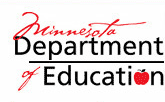|
Language Arts
2010 Revision
College and Career Readiness Anchor Standards for Speaking,
Viewing, Listening and Media Literacy
Media Literacy
- Critically analyze information found in electronic, print, and mass media and use a variety of these sources.
- Communicate using traditional or digital multimedia formats and digital writing and publishing for a specific purpose.
0.8.7.7 Distinguish among different types of print, digital, and multimodal media.
Speaking, Viewing, Listening and Media Literacy Benchmarks K-5
- Recognize common signs and logos.
- Identify commercials or
advertisements.
2.8.7.7 Distinguish, understand, and use different types of print, digital, and multimodal media
5.8.7.7 Distinguish among, understand, and use different types of print, digital, and multimodal media.
- Make informed judgments about messages promoted in the mass media(e.g., film, television, radio, magazines,advertisements, newspapers).
- Locate and use information in print, non-print, and digital resources using a variety of strategies.
- Evaluate the accuracy and credibility of information found in digital sources.
- Recognize ethical standards and safe practices in social and personal media communications.
8.9.7.7 Understand, analyze, and use different types of print, digital, and multimodal media.
- Evaluate mass media with regard to quality of production, accuracy of information, bias, stereotype, purpose,message and target audience (e.g., film, television, radio, video games, advertisements).
- Critically analyze the messages and points of view employed in different media (e.g., advertising, news programs, websites, video games, blogs, documentaries).
- Analyze design elements of various kinds of media productions to observe that media messages are constructed for a specific purpose
|
Social Studies
http://cfl.state.mn.us/
bestpractice/
chapter4.pdf
|
Health
Analyze the influence of culture, media, technology and other factors on health
How internal and external factors like personal preferences, family and cultural eating habits, friends and the media and advertising influence eating habits
HS Content Standards
Students must complete three Individual and Community Health AND Physical Education and Fitness AND Career Investigation OR Occupational Experience
Individual & Community Health
A student shall demonstrate an understanding of decision-making and community health practices that promote healthful nutrition and dietary practices, and physical fitness, and that reduce and prevent tobacco use, drug and alcohol use, intentional and unintentional injuries, HIV, sexually transmitted diseases, and unintentional pregnancies by:
- analyzing how health maintenance and disease prevention decisions are influenced by the media, technological advances, interpersonal communication, and immediate and long-term risk factors; and
- creating a plan for an in-depth study of one of the community health practices described in this subpart including in-depth information needed, procedures required, how this area is impacted by other community health practices, and options for completing an indepth study.
This standard requires completion of the in-depthstudy
|
Information & Technology Literacy (Oct. 2004)
Reading & Media Literacy
http://www.memoweb.org/
links/
infotechlitstandards.pdf
9-12th grade Benchmarks
- Students explain how meaning is conveyed in image, sound, and artistic works and gain understanding that most media messages are constructed to gain profit and/or influence.
- Students analyze design elements of various kinds of media productions and gain understanding that media messages have embedded values and points of view.
3. Students analyze media for purpose, message, accuracy, bias, and intended audience and gain understanding that media messages are constructed using a creative language with its own rules.
|




